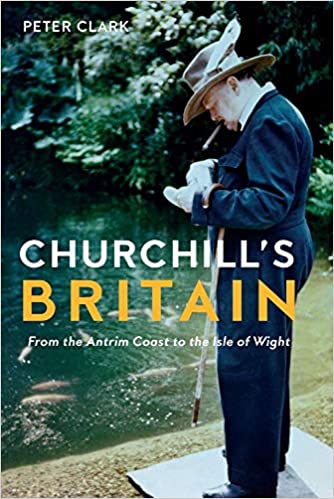
Finest Hour 191
Churchillian Geography

and first President of Israel
January 1, 1970
Finest Hour 191, First Quarter 2021
Page 41
Review by Peter Clarke
Peter Clarke is author of Mr. Churchill’s Profession: Statesman, Orator, Writer (2012).
Peter Clark, Churchill’s Britain: From the Antrim Coast to the Isle of Wight, Haus, 2020, 294 pages, £20. ISBN 978–1909961746
I share more than a homophone with the author of this book. We are both irresistibly drawn into following the career of a man who so often departed from the highway of politics into byways that successively complicated—and sometimes compromised—the unfolding of his extraordinary career. Peter Clark brings a well-honed literary facility to the task of creating this highly readable book. He had the bright idea of telling the Churchill story, which has so often been told chronologically, year by year, by instead laying it out topographically, place by place.
Thus we begin focused on a very small area of the United Kingdom: the postal district of London SW1. This covers the city of Westminster, which is of course synonymous with the parliamentary institutions that beckoned young Winston from an early age. He duly made politics his vocation, just like his father before him, though with a measure of hard work, success and achievement that Lord Randolph never displayed. In only a few pages we reach Downing Street: not only Number 10 as the official residence of the Prime Minister, with Churchill’s wartime role inevitably to the fore, but also Number 11 as the home of the Chancellor of the Exchequer, the post that Churchill held in the 1920s.

2025 International Churchill Conference
Thus there is no difficulty in getting this book moving, with an early evocation of themes, incidents, associations and anecdotes that the author can readily draw upon as he conducts his guided tour. But has he shot his bolt in giving us too much, too soon, with perhaps too little left to sustain interest in the rest of his book? In a sense, he could not fail in this first chapter, precisely because there are so many associations with the great moments in Churchill’s career. The author duly delivers by rooting many of the anecdotes he tells in the specific context of buildings that he has obviously visited with a keen eye for detail, and often with a word of explanation about changes that have subsequently taken place. All of this is admirable testimony to the rigour with which he has approached his task, as seen too in the citation of his sources with numbered references that can be followed up through the notes supplied at the back of the volume. But though these list the full bibliographical details of the publications cited, it is irritating (and my only scholarly cavil) that no page references are supplied—often for volumes that run to a thousand pages.
The author’s real triumph, I think, is to sustain the interest evoked with such ease in his first chapter. Thus the book does not flag when we move outside the tight, privileged circle of power and influence in central London. In the succeeding chapters, each with a helpful map identifying the places mentioned, we move steadily through the London suburbs, and beyond the Home Counties, where Churchill spent most of his life. Certainly there is special attention for his various homes, with his search for a country house ultimately flowering in the purchase of Chartwell. This was situated in the part of England he knew best, on the borders of Surrey and Kent, simultaneously his romantic vision of “Deep England” and also a convenient distance for a commuter who had to keep in touch with Westminster.
Other parts of the United Kingdom were frankly less resonant in his life; but the author does well to hold our attention as his topographical survey expands its scope to cover not only the other parts of southern England but, in three final chapters, the North of England, Scotland, and Ireland. And in each of these chapters, the author can point to the centrality of some of the places in his gazetteer in evoking crucial early links in the chain that was Churchill’s early career, as a Liberal and an Irish Home Ruler—less familiar perspectives, perhaps, for many readers. There is plenty here for everyone.
Subscribe
WANT MORE?
Get the Churchill Bulletin delivered to your inbox once a month.





